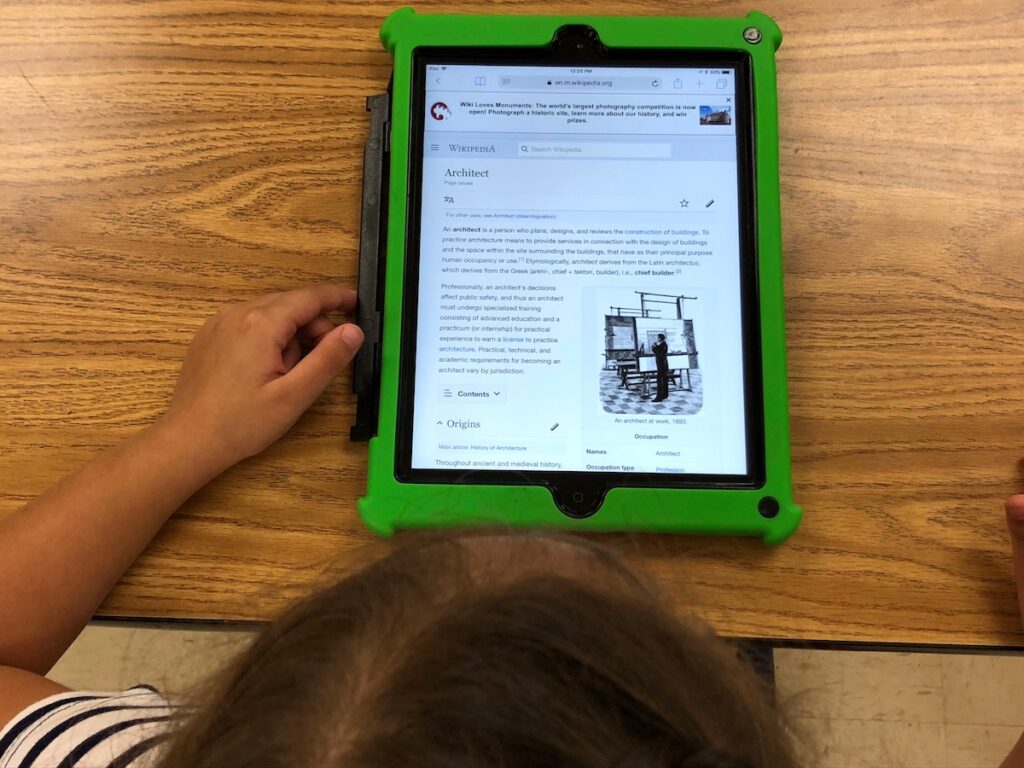Teaching your students about art careers is exciting. From discussions to hands-on exploration, there are many ways to accomplish the goal.
One effective way to expose students to art careers is through research. The ability to research is an important life skill and something they can hone in the art room. Letting your students research different art careers will give them a broad sense of the possibilities.
Here are 5 Steps to Plan Your Own Art Career Research Unit
This unit takes students from researching to creating to presenting. It’s an exciting way for them to get to know about many different art careers in a short period of time.
1. Introduce Art Careers

Begin this unit by introducing a variety of art careers to your students. Be sure to include popular, well-known options alongside more obscure choices.
Here is a list of art careers you could share.
Or, check out a complete list of sixty choices here!
- Artist
- Illustrator
- Animator
- Jeweler
- Weaver
- Architect
- App Designer
- Photographer
- Tattoo Artist
- Special Effects Makeup Artist
- Art Therapist
- Art Director
- Video Game Designer
- Art Historian
- Costume Designer
- Digital Illustrator
You can introduce these using a slide presentation, class discussion, handout, or another method.
2. Begin Research

After your introduction, it is time for students to begin to dive deep and start their own research. Students can look into art careers you shared or search for their own. Give your students books and access to technology to help them gather more information. If you haven’t already, this is the time to talk about plagiarism and the importance of citing sources.
At this time, think about whether you will let students work in pairs or groups. This unit can easily accommodate collaborative learning.
A handout is an effective way to help guide students through the research phase. This is especially important for students who are new to research.
You can develop your own or use the one below!
3. Plan Projects
Next, students must decide how they are going to present what they learned to the class. Creating a thorough plan will help them have a solid foundation for their project.
Allowing choice is important. Doing so will create more buy-in. Two options for projects include creating a slide presentation or creating an original piece of art, like a drawing or a sculpture. Whatever options you decide to include, make sure you spell out the exact requirements for each. Here are a few examples.
Slide Presentation Requirements
- Share why this career interests you.
- Include 5-6 images of work that comes from your chosen career. Make sure to include a link to the original source for each.
- Share 4-5 facts about one famous/notable person in the field.
- Share one new thing you learned about this career.
Original Art Requirements
- Create an original piece of work that exemplifies the art career you researched.
- Share why this career interests you.
- Share three facts about the career.
- Share one famous/notable person in the field.
4. Create Work

At this point, your students have done their research and made a plan. Now, give them the resources they need in order to create their presentations and make original art. During this time, make sure you are circulating the classroom to help facilitate learning.
5. Present
After their work is complete, students are ready to share. This is where all the hard work comes together. As their classmates present, students are able to learn about a variety of art careers.
Creating a Dynamic Hallway Display
It’s always a good idea to share what happens in your classroom. However, figuring out how to display a presentation can be difficult. One way to overcome this is by using QR codes. Take a photo of each student or group of students as they present.
For students who created original art, hang the photo next to the finished piece. For students who created slide presentations, hang the photo next to a QR code that links to the presentation. This way, your viewers will be able to see all the work created in your class!
Overall, this unit is a great way to give your students research experience, to explore technology, and to learn more about art careers.
How do you expose your students to art careers?
What type of research opportunities do you give your students?
Magazine articles and podcasts are opinions of professional education contributors and do not necessarily represent the position of the Art of Education University (AOEU) or its academic offerings. Contributors use terms in the way they are most often talked about in the scope of their educational experiences.






